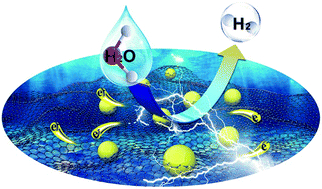Carbon quantum dots enhanced the activity for the hydrogen evolution reaction in ruthenium-based electrocatalysts†
Abstract
The development of effective and inexpensive hydrogen evolution reaction (HER) electrocatalysts for future renewable energy systems is highly desired. Carbon-based metal hybrid materials with unique edge sites, good chemical stability, high electrical conductivity, and synergetic effects exhibit great potential. However, there are few studies on the effect of the carbon-based support on catalytic performance. In this study, we explored the synergy between the carrier and metal (Ru), and studied the effect of the carrier and metal crystallinity on the catalytic performance of HER. The performance of Ru nanoparticles (Ru NPs) catalyst supported on carbon quantum dots (Ru@CQDs) was superior to that on other carbon supports. In addition, the HER performance of the Ru@CQDs catalyst was highly dependent on the crystallinity and confinement effects. Experimental results indicate that the Ru NPs were successfully anchored by strong coordination interactions between the d orbitals of Ru and the surface functional groups of CQDs, which is beneficial to the confinement of Ru NPs around the CQDs and to prevent their aggregation. The results will guide the design of inexpensive Ru-based HER electrocatalysts.

- This article is part of the themed collections: Energy Frontiers: Hydrogen and Carbon Dots


 Please wait while we load your content...
Please wait while we load your content...